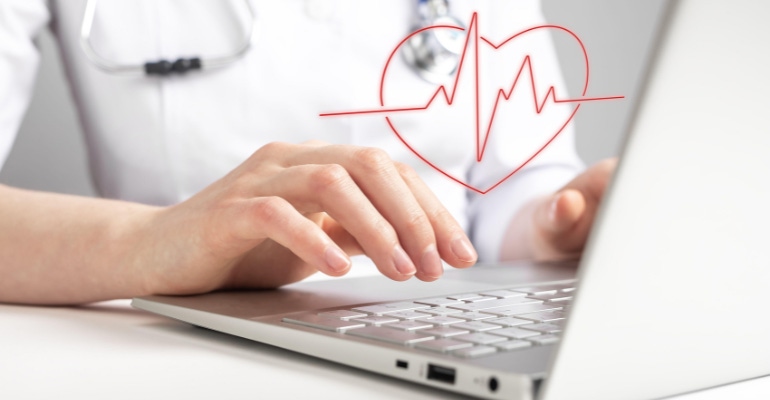Artificial intelligence is finding its way into nearly every corner of the medical device space. Here's the latest example of this trend.
July 15, 2022

Artificial intelligence is finding its way into healthcare at an astonishing rate. A new collaboration between Novartis Pharmaceuticals and Anumana is the latest example of how both pharma and medtech are embracing AI.
The multi-year strategic collaboration is intended to drive development and delivery of electrocardiogram (ECG) artificial intelligence algorithms to help physicians accelerate detection and intervention for patients with previously undetected heart disease. The ECG AI algorithm is still in development.
The collaboration will support Anumana’s efforts to implement AI-enabled diagnostic software that can detect signals from ECGs that humans cannot interpret. The collaboration will initially focus on cardiovascular diseases. Working with its partners at Mayo Clinic, Anumana will deploy solutions that use artificial intelligence to analyze an ECG, a test that records the heart’s electrical signals to identify undiagnosed left ventricular dysfunction, or a weak heart pump, which can lead to heart failure. The AI will also screen for atherosclerotic cardiovascular disease, which can lead to heart attack and stroke. In addition, an evidence-based, digital point-of-care solution will be developed to guide in optimizing guideline-directed medical therapies with the aim to lower risk for potentially avoidable hospitalizations and cardiovascular death.
“Anumana technology is designed to help physicians identify patients who are at maximum risk of heart failure, long before they develop symptoms,” said Anumana CEO Murali Aravamudan. “Bringing together premier global organizations will allow us to expand access to best-in-class, AI-powered digital tools to benefit patients through earlier detection and intervention, when and where health care providers need it most.”
“Many heart diseases develop for years before signs and symptoms appear, but the first event may be life threatening,” said Paul Friedman, M.D., Chair of the Department of Cardiovascular Medicine at Mayo Clinic and Chair of Anumana’s Mayo Clinic Board of Advisors. “AI enables us to uncover hidden signals our bodies transmit to detect otherwise occult heart diseases, potentially years before symptoms appear. This collaboration has the potential to transform the use of a ubiquitous inexpensive test, the ECG, with the aim of democratizing disease detection and helping medical care teams to proactively manage heart disease ahead of time and prevent some clinical events from ever happening.”
“Cardiovascular disease is a widespread and multifactorial disease and, in order to mitigate its impact, we must look beyond therapeutic innovation and reimagine how we approach cardiovascular care,” said Victor Bulto, President, Novartis Innovative Medicines US. "Novartis is proud to collaborate with Anumana on innovative and data-driven solutions to better predict the risk of life-threatening heart disease, further driving forward our commitment to improving patient experiences and population health outcomes in this patient population.”
The Mayo Clinic cardiology team, led by Friedman, pioneered the application of artificial intelligence in cardiology and developed several algorithms based on millions of ECGs, including a low ejection fraction algorithm that received FDA breakthrough device designation in 2019 and emergency use authorization for COVID-19 in 2020. Further validating the technology, a recent study presented by Mayo Clinic used a modified version of Anumana’s 12-lead ECG algorithm to detect left ventricular dysfunction with single-lead ECGs in smartwatches. These algorithms are licensed to Anumana for development of clinical solutions and have been validated by over 30 peer-reviewed publications, including a first of its kind prospective clinical impact study on low ventricular ejection fraction that was published in Nature Medicine in 2021. These software solutions are currently in development with each algorithm as a candidate for marketing authorization through an FDA de novo request.
Other recent examples of artificial intelligence in healthcare
Eko is using artificial intelligence to reimagine the stethoscope. The Oakland, CA-based company recently secured FDA clearance for an AI algorithm to identify structural heart murmurs using a smart stethoscope. The Eko Murmur Analysis Software for detecting and characterizing murmurs found in adults and pediatric patients is now ready for the market.
“This clearance gives us the ability to commercialize and get into market a novel heart disease detection AI algorithm that allows physicians to use their stethoscope with more confidence and be able to detect signs of cardiovascular disease like valvular heart disease,” Connor Landgraf, co-founder and CEO at Eko, told MD+DI.
The Novartis-Anumana collaboration is also proof that pharmaceutical companies are eager to hop onto the artificial intelligence bandwagon with medical device companies.
Merck recently announced its plan to dive deeper into the space. The pharma powerhouse launched the Merck Digital Sciences Studio (MDSS), which is intended to help early-stage biomedical startups with direct investment, access to powerful Azure Cloud computing, and opportunities to pilot their technologies in collaboration with discovery and clinical scientists at Merck. The Rahway, NJ-based company said it welcomes applications for 12 spots for the first MDSS cohort. Merck said startups developing artificial intelligence and machine learning applications will be prioritized.
Catch up on other recent developments involving artificial intelligence here.
About the Author(s)
You May Also Like




